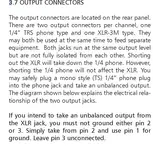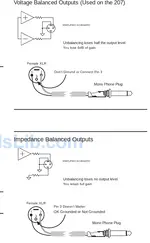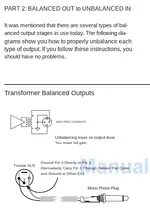I will guess most "non electronic" musicians start with a guitar cable.
Then rise to the complex Mic XLR and maybe delve into the science of the instrument cable vs speaker cable.
Later on , if into recording gear and seeking holy grail sounds, the Engineering and Marketing confusion happens.
Questions of "Why do some preamps have transformers or not, discrete or IC or tube?" Things get more confusing and articles saying warm, clean, fuzzy, overdrive, Neve, Beatles mics lead to Neumann Mics, Preamps, Impedance, condensor, tube, hybrid..yikes! Input, Output, TRS , XLR, T/S Line, T/S Speaker and more.
Then mix matching Balanced and Non-Balanced gear might be asked to 1) get best signal transfer 2) not damage any gear.
I just assume Focusrite techs are a mixed bag, some have ISA experience aka Hardware, while many have 2i2 audio interface type experience and not up on Transformers instead USB and software expertise.
Why does one system offer balanced Line In and others offer non-balanced Line In anyway? just to save a buck it seems.
I would naturally assume my fellow musicians wouldn't care very much about how things work, they just want to plug in and jam and just want to know how to hook stuff up nicely.
Later on, it seems they asked me about one complexity or another, because the internet if full of audiophile garbage propaganda to sell an item, and they wanted to know an opinion from me that builds and repair electronics including audio but it all goes down to this: Some audio units are created with the intention of being transparent, in the regards it only does its function (like compression), but some are intentionally created to enhance, transform, or 'color' the sound besides to provide its basic function. Now someone might use a device like a vacuum tube induce this characteristic, but in reality, it all depends on how the circuit is created to provide its 'coloring' effects. A tube circuit can be clean and transparent if it is created to do so.
mixing and matching different types of i/o (balanced & unbalanced) with someone that is conscientious of the quality of sound will try the possible connections with cabling, but in certain settings (like a bunch of rack mount unbalanced gear) most will use signal transformers to convert to a balanced audio to isolate the self noise the unbalanced units add when they are normally connected with unbalanced i/o.
I've notice over the years the simple mistakes new electronics engineers make get slowly incorporated into their gear. Even their ISA amp is a victim of this and why the older models are sought after by audio engineers that know and hear its differences.
A 100% balanced circuit is actually two unbalanced circuits where the signal's ground (actually its 'common' instead of 'ground' because its AC) is not referenced to the power supply and rejects differences between the inverted (-) and non inverted (+) signal. Creating a 100% balanced circuit throughout requires tight tolerances between the same parts the inverted signal and non inverted signal stages. So, a collector resistor in the + signal's 1st stage has to be exactly equal to the collector resistor in the - signal's 1st stage. So someone has to match these devices instead of throwing the parts in a hopper and have a robot indiscriminately insert it into the board at high speed. Besides high end equipment, no one designs these audio circuits this way. They make unbalanced circuits because its half the parts build, and its much easier to mass produce. On converters, there is little choices they have because they are using an IC someone else designed and have to conform to the design standards the IC was created. So, if TI only makes a usb a/d d/a converter chip and chooses to design it with unbalanced analog in, the circuit created around it has to created in the same unbalanced fashion. The only reason why an ic circuit like this would have a balanced input is that they purposely wanted a balanced input, but that stage's output is unbalanced. But a short answer is yes unbalanced circuits are cheaper to build.
Until sometime in the 70s unbalanced gear only existed in musical instruments. Mainly because the low noise amplifying devices that can be used as unbalanced signal circuits were not easily mass produced as it is today. The older analog mixers that all of them are unbalanced internally were much more expensive because they had to hand pick parts. Old studio guys still force balanced connection compliance because they know its the correct and established standard that studio signal interconnections should fallow. Unbalanced was a live sound interconnect (insert jack) and musical instrument interconnection and did not belong in the studio world back in the day.
BTW, I have Dave (ecc83) ignored on purpose because he rambles on sensuously in threads, and doesn't provide intelligent answers that make sense.




